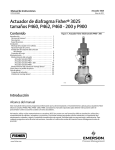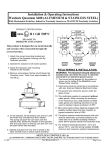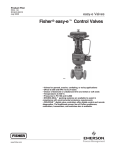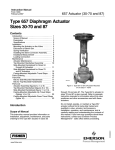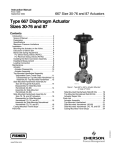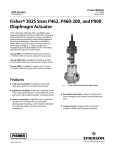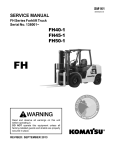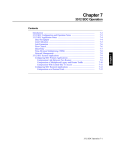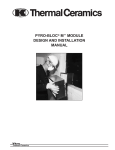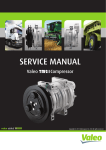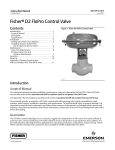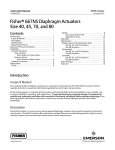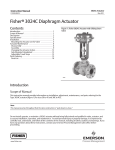Download Emerson Fisher 3025 Installation Instructions
Transcript
Instruction Manual 3025 Actuator D251402X012 May 2011 Fisherr 3025 Sizes P460, P462, P460-200, and P900 Diaphragm Actuator Contents Figure 1. Fisher 3025 Size P460-200 Actuator Introduction . . . . . . . . . . . . . . . . . . . . . . . . . . . . . . . . . 1 Scope of Manual . . . . . . . . . . . . . . . . . . . . . . . . . . . . . 1 Description . . . . . . . . . . . . . . . . . . . . . . . . . . . . . . . . . 2 Specifications . . . . . . . . . . . . . . . . . . . . . . . . . . . . . . . 2 Installation . . . . . . . . . . . . . . . . . . . . . . . . . . . . . . . . . . . 2 Mounting the Actuator on the Valve . . . . . . . . . . . . 3 Travel Stop Adjustment . . . . . . . . . . . . . . . . . . . . . . . 4 Installing the Stem Connector Assembly . . . . . . . . . 5 Loading Connection . . . . . . . . . . . . . . . . . . . . . . . . . . 6 Maintenance . . . . . . . . . . . . . . . . . . . . . . . . . . . . . . . . . 6 Actuator Maintenance . . . . . . . . . . . . . . . . . . . . . . . . 6 Size P460 Actuator . . . . . . . . . . . . . . . . . . . . . . . 7 Size P462 Actuator . . . . . . . . . . . . . . . . . . . . . . . 9 Size P460-200 Actuator . . . . . . . . . . . . . . . . . . 12 Size P900 Actuator . . . . . . . . . . . . . . . . . . . . . . 14 Side Mounted Handwheel Maintenance . . . . . . . . . 18 Parts Ordering . . . . . . . . . . . . . . . . . . . . . . . . . . . . . . . 21 Parts List . . . . . . . . . . . . . . . . . . . . . . . . . . . . . . . . . . . 22 Actuator Assembly . . . . . . . . . . . . . . . . . . . . . . . . . . 22 Side-Mounted Handwheel . . . . . . . . . . . . . . . . . . . . 23 W9088 Introduction Scope of Manual This instruction manual includes installation, maintenance, and parts information for Fisher 3025 actuators in sizes P460, P462, P460-200, and P900. Refer to separate manuals for instructions covering the positioner and other accessories used with these actuators. Do not install, operate, or maintain 3025 actuators without being fully trained and qualified in valve, actuator, and accessory installation, operation, and maintenance. To avoid personal injury or property damage, it is important to carefully read, understand, and follow all the contents of this manual, including all safety cautions and warnings. If you have any questions about these instructions, contact your Emerson Process Management sales office before proceeding. www.Fisher.com Instruction Manual 3025 Actuator May 2011 D251402X012 Description The Fisher 3025 size P460, P462, P460-200 and P900 spring-opposed diaphragm actuators position the valve plug in the valve body in response to varying controller or valve positioner pneumatic output signals applied to the actuator diaphragm. They can be specified either direct (air-to-close) or reverse acting (air-to-open). The size P460 offers 65 mm maximum actuator travel. The sizes P462 and P900 provide 120 mm maximum actuator travel. The size P460-200 offers 203 mm maximum actuator travel. The 3025 actuator can be equipped with a side-mounted assembly. It is usually used as an auxiliary manual actuator. Table 1. Specifications ACTUATOR SIZE SPECIFICATION Nominal Effective Area Yoke Boss Diameter Acceptable Valve Stem Connection Maximum Travel Maximum Diaphragm Casing Pressure Temperature Capabilities Pressure Connections (female) Approximate Actuator Weights Approximate Side Handwheel Weights P460 P462 P460-200 P900 cm2 1800 1800 1800 3600 inch2 279 279 279 558 3-9/16 inch x x x --- 5 inch x x x x 5H inch x x x x 75 mm x x --- --x 120 mm x x --- 130 mm --- --- --- x 3/4-16UNF x x x --x 1-14UNS x x x 1-1/4-12UNF x x x x M16 x x --- --- M20 x x --- x M30 x x --- x mm 65 120 203 120 inch 2-5/8 4-3/4 8 4-3/4 x bar 4 Psig 58 _C -30 to 80_C _F -22 to 176_F 1/2 NPT x x x 3/4 NPT x x --- x 1 NPT --- --- x --- kg 140 190 250 430 lb 310 420 640 1000 kg 40 40 100 65 lb 90 90 220 140 Specifications Refer to table 1 for Specifications of the 3025 actuator. See the actuator nameplate for specific information about your actuator. Installation Key number locations are shown in figures 3 through 12, unless otherwise indicated. Figures 3 and 4 show the size P460 actuator, figures 5 and 6 the size P462, figures 7 and 8 the size P460-200 and figures 9, 10, 11 and 12 illustrate the size P900. 2 Instruction Manual D251402X012 3025 Actuator May 2011 If the actuator is equipped with a side-mounted handwheel, also refer to the figures 13, 14, 15 and 16. Figure 13 shows the size P460 and the size P462 side-mounted handwheel, figure 14 the size P460-200 and figure 15 illustrates the size P900. CAUTION To avoid parts damage, do not use a normal operating pressure that exceeds the Maximum Diaphragm Casing Pressure of 4 bar or produces a force on the actuator stem greater than the Maximum Allowable Valve Stem Load. D Valve/Actuator Assembly: If the actuator and valve are shipped together as a control valve assembly, it has been adjusted at the factory, and may be installed in the pipeline. After installing the valve in the pipeline, refer to the Loading Connection procedures. D Actuator Mounting: If the actuator is shipped separately or the actuator has been removed from the valve, it is necessary to mount the actuator on the valve before placing the valve in the pipeline. Refer to the actuator mounting procedures before placing the valve in service. D Positioner: If a positioner is installed, or is to be installed on the actuator, refer to the positioner instruction manual for installation. During the adjustment procedures, it will be necessary to provide a temporary loading pressure to the actuator diaphragm. CAUTION The 3025 diaphragm actuators are designed to mount on push-down-to close valves. Do not mount these actuators on any other type of valve without first contacting your Emerson Process Management sales office. Mounting the Actuator on the Valve CAUTION If the valve stem is allowed to remain in the up position (towards the actuator) during mounting, it can interfere with the actuator mounting, possibly damage valve stem threads or bend the valve stem. Be sure the valve stem is pushed down (into the valve body), away from the actuator while mounting. CAUTION If the actuator is equipped with a side-mounted handwheel, during mounting it can interfere with the valve stem (even if the valve stem is pushed completely down into the valve body), possibly damage valve stem threads or bend the valve stem. Be sure the actuator stem is sufficiently retracted (into the side-mounted handwheel), away from the valve while mounting. If not, the actuator stem can be retracted by turning counterclockwise the handwheel. Be sure the actuator stem does not rotate while turning the handwheel (use the anti-rotator to prevent rotation). 1. Provide a vise or some other method of supporting the valve and the weight of the actuator during assembly. Push the valve stem down away from the actuator while mounting the actuator. 3 3025 Actuator May 2011 Instruction Manual D251402X012 2. Lift or hoist the actuator onto the valve bonnet: a. For the 3-9/16 yoke boss: Slowly lower the actuator down onto the valve. As the yoke passes over the end of the valve stem, place the yoke locknut over the valve stem. Once the actuator is in place, screw the yoke locknut onto the valve bonnet and tighten the locknut. b. For all other yoke bosses: Slowly lower the actuator down onto the valve. Once the actuator is in place, insert the cap screws and tighten the hex nuts, securing the actuator to the bonnet. Travel Stop Adjustment The actuator is normally shipped adjusted at the factory and you may refer directly to the Installing the Stem Connector Assembly procedures. If the actuator has been disassembled, it is necessary to adjust the travel stop. You may perform the following procedure before connecting the actuator stem to the valve stem. WARNING When moving the actuator stem with loading pressure applied, exercise caution to keep hands and tools out of the actuator stem travel path. If the loading pressure is accidentally disconnected, personal injury and property damage is possible if something is caught between the actuator stem and other control valve parts. Also provide a certified pressure gauge suitable to accurately read the diaphragm pressure from 0 through the upper bench set pressure marked on the nameplate. Apply loading pressure to the diaphragm. Stroke the actuator a few times to ensure that the pressure gauge is working correctly, and that the actuator is functioning properly. It is important to be sure that the actuator assembly is not binding or producing any loading friction on the actuator stem movement. Note For push-down-to-close valves, the valve plug is the limit for downward travel and the actuator up-stop is the limit for upward travel (away from the valve). 1. If not already accomplished, provide a temporary means of applying adjustable loading pressure to the actuator during the travel stop adjustments. 2. Remove the cap (key 43, figures 3 through 6) or loosen the locknut (key 42, figures 7 through 12). Unscrew the travel stop (key 41). 3. Perform one of the following procedures as appropriate: a. For an air-to-open actuator: apply the upper bench set loading pressure to the diaphragm. Adjust the travel stop (key 41) so that it touches the actuator stem. Then lock the travel stop by replacing the cap (key 43) or by tightening the locknut (key 42). b. For an air-to-close actuator: apply the lower bench set loading pressure. The actuator should show movement at the lower bench set pressure. Adjust the travel stop (key 41) so that it touches the actuator stem. Then lock the travel stop by replacing the cap (key 43) or tightening the locknut (key 42). 4. Stroke the actuator and check that the actuator is capable of the travel shown on the travel indicator scale (key 74). If the travel span is correct, travel stop adjustment is complete. Proceed to the Installing the Stem Connector Assembly subsection. 4 Instruction Manual D251402X012 3025 Actuator May 2011 5. If the travel span is not correct, a wrong or damaged spring has been installed in the actuator. To obtain the correct spring sizing information, refer to Fisher Catalog 14, Actuator Sizing and Sample Calculations to determine the correct spring selection for your application. Or contact your Emerson Process Management sales office for assistance. After replacing the spring, repeat the steps above. Installing the Stem Connector Assembly When installing the stem connector assembly, the actuator and valve stem threads should engage the threads of the stem connector by a distance of the diameter of the stem. 1. If necessary, push the valve stem down so that it is touching the seat ring. 2. For an air-to-open actuator only, set the diaphragm loading pressure to approximately 0.5 bar over the upper bench set pressure. The actuator stem should be contacting the upper travel stop. 3. For the size P900 only, screw the actuator and valve stem locknuts away from the connector halves locations. 4. Screw the two stem connectors halves (keys 78 and 79) onto the valve stem and actuator stem. Then place the travel indicator (key 84), the spacer if used (key 86) and the anti-rotator (key 85) on the valve stem connector half. 5. To adjust the travel, perform one of the following procedures as appropriate: a. If the actuator is equipped with a side-mounted handwheel: turn the handwheel so that the distance between the anti-rotator and the actuator stem connector half is equal to the valve travel. Be sure the actuator stem does not rotate while turning the handwheel (use the anti-rotator to prevent rotation). Be sure that the actuator and valve stem threads are engaging the threads of the stem connectors by the distance of at least one diameter of the stem. b. If the actuator is not equipped with a side-mounted handwheel: rotate the connector halves so that the distance between the anti-rotator and the actuator stem connector half is equal to the valve travel. Be sure that the actuator and valve stem threads are engaging the threads of the stem connectors by the distance of at least one diameter of the stem. CAUTION Incomplete engagement of the stem connector onto either the valve stem or actuator stem can result in stripped threads or improper operation. Be sure that the length of the actuator stem or the valve stem in the connector is equal or greater than the diameter of that stem. Damage to threads on either stem or in the stem connector can cause the parts to be replaced prematurely. 6. Perform one of the following procedures as appropriate: a. For an air-to-open actuator: Slowly decrease the diaphragm pressure and line up the stem connector halves. b. For an air-to-close actuator: Slowly increase the diaphragm pressure and line up the stem connector halves. 7. Install the cap screws (key 87) with the lock washers if used and tighten them. 8. For sizes P460, P462 and P460-200, install the cap screws (key 80) and the nuts (key 81) and tighten them. For the size P900, screw the valve and actuator stem locknuts against the stem connector halves. 9. Slowly increase and decrease pressure several times, stroking the valve from the lower bench set pressure to the upper pressure. 10. Adjust the travel indicator scale (key 74) to correspond with the travel indicator. Stroke the valve full travel to ensure that the travel matches the valve travel on the travel indicator plate. If travel is not correct repeat the stem connector procedure. 5 3025 Actuator May 2011 Instruction Manual D251402X012 11. If the actuator is equipped with a side-mounted handwheel, insert the screw (key 139) and the nut (key 140) into the stem connector half (key 78). Then screw the nut against the stem connector half. Adjust the handwheel travel indicator (key 113) to correspond with the screw (key 139) used as neutral position indicator. It may be necessary to take off the protective covers (key 119) by removing the cap screws and washers (keys 120 and 128). Once adjusted, replace the protective covers, washers and tighten the screws. Loading Connection The loading pressure connections are made at the factory if the valve, actuator, and positioner come as a unit. Keep the length of tubing or piping as short as possible to avoid transmission lag in the control signal. If a volume booster, valve positioner or other accessory is used, be sure that it is properly connected to the actuator. Refer to the positioner instruction manual or other manuals as necessary. For actuators shipped separately or whenever the actuator pressure connections are installed, use the following steps: 1. Connect the loading pressure piping to the NPT internal connection at the side of the diaphragm casing. 2. Cycle the actuator several times to be sure that the valve stem travel is correct when the correct pressure ranges are applied to the diaphragm. 3. If valve stem travel appears to be incorrect, refer to the travel stop adjustment procedures at the beginning of this section. Do not place the valve in service if it is not reacting correctly to diaphragm loading pressure changes. Maintenance Actuator parts are subject to normal wear and must be inspected and replaced when necessary. The frequency of inspection and replacement depends on the severity of service conditions. WARNING Avoid personal injury or property damage from sudden release of process pressure or bursting of parts. Before performing any maintenance operations: D Do not remove the actuator from the valve while the valve is still pressurized. D Disconnect any operating lines providing air pressure, electric power, or a control signal to the actuator. Be sure the actuator cannot suddenly open or close the valve. D Use bypass valves or completely shut off the process to isolate the valve from process pressure. Relieve process pressure from both sides of the valve. Drain the process media from both sides of the valve. D Vent the power actuator loading pressure and relieve any actuator spring precompression. D Use lock-out procedures to be sure that the above measures stay in effect while you work on the equipment. When performing maintenance procedures, isolate the control valve from the process line pressure from both sides of the valve. Use the lock-out procedures to be sure that the above measures stay in effect while you are working on the actuator. Actuator Maintenance This procedure describes how the actuator can be completely disassembled and assembled. When inspection or repairs are required, disassemble only those parts necessary to accomplish the job; then, start the assembly at the appropriate step. 6 Instruction Manual D251402X012 3025 Actuator May 2011 Key numbers refer to figures 3 through 12 unless otherwise indicated. Figure 3 and 4 show the size P460, figure 5 and 6 the size P462, figure 7 and 8 the size P460-200 and figures 9 through 12 illustrate the size P900. It may be necessary to apply a temporary loading pressure to the actuator during the disassembly. Size P460 Actuator Size P460 Actuator Disassembly 1. Bypass the control valve. Reduce the loading pressure to atmospheric, and remove the tubing or piping from the diaphragm casing (key 1). 2. If the actuator is equipped with a side-mounted handwheel, refer to the Side-Mounted Handwheel Disassembly procedures in the Side-Mounted Handwheel Maintenance section to separate the actuator and handwheel (steps 2 to 7). Then continue the Size P460 Actuator Disassembly procedure from the step 8. 3. For an air-to-open actuator only: slightly pressurize the actuator diaphragm until movement of the actuator stem is detected and the spring force applied to the stem connector is relieved. WARNING To avoid personal injury due to sudden uncontrolled movement of parts, do not loosen yoke locknut or cap screws and do not remove parts of the stem connector when the stem connector has spring force applied to it. 4. Remove the stem connector cap screws (key 87), the anti-rotator (key 85), the spacer if used (key 86) and the travel scale indicator (key 84). Loosen the stem connector halves cap screws and nuts (keys 80 and 81). Remove the stem connector halves. 5. For an air-to-open actuator only: slowly exhaust the diaphragm pressure. 6. To separate the actuator from the valve body, remove the yoke locknut or the bolts and then lift off the actuator. 7. Remove the yoke cap screws (key 77) and then lift the actuator off the yoke. 8. Remove the lifting lug cap screws (key 44), the lifting lug (key 40) and the gasket (key 71). If required remove the cap (key 43) and the travel stop (key 41). WARNING To avoid personal injury from the precompressed spring force thrusting the diaphragm casing away from the actuator, carefully remove casing cap screws and nuts (keys 45 and 46) (step 9 below) and then relieve the spring compression by unscrewing the nut (key 16) (step 11 below). 9. Remove all the diaphragm casing cap screws and nuts (keys 45 and 46). If required remove the vent (key 49). 10. Remove the set screws (key 57) and if used the travel stop and locknut (keys 65 and 66). 11. Relieve the spring compression by unscrewing slowly the nut (key 16). 12. Remove the washer (key 53), then lift off the diaphragm casing (key 3). 13. Remove the actuator springs (keys 30 and 31). 14. Lift off the stem and diaphragm plate assembly. 15. Unscrew the travel stop (key 54), remove ring (key 17), the wave washers (key 12), the tube (key 51), the diaphragm plate (key 26), the diaphragm (key 47), the O-ring (key 6), the washers if used (key 64) and the travel stop (key 14). Unbend the tab washer (key 13), remove the retaining ring (key 11) and the two nut halves (key 10). 7 3025 Actuator May 2011 Instruction Manual D251402X012 16. From the diaphragm casing (key 1) remove the retaining ring (key 8), the wiper ring and the seal retainer (keys 4 and 5) and the O-ring (key 6). 17. If required remove the casing bushings (keys 7 and 33), the pins (key 28) from the diaphragm casing and diaphragm plate, the hellicoils (key 58), the travel scale, screw and nuts (keys 74, 75 and 76). Size P460 Actuator Assembly 1. If removed, coat the bushings (keys 7 and 33) with lithium grease (key 201) and slide them into the diaphragm casings. 2. Place the wiper ring (key 4) into the seal retainer (key 5). Apply lithium grease (key 201) to the O-ring (key 6), the wiper ring and seal retainer assembly and install them into the diaphragm casing (key 1). Then place the retaining ring (key 8). 3. If removed, insert the pins (key 28) into the diaphragm casing (key 3) and diaphragm plate (key 26). 4. If removed, insert the hellicoils (key 58) into the nut (key 16). 5. Coat the threads of the stem (key 9) with anti-seize lubricant (key 202). 6. Apply anti-seize lubricant (key 202) to the internal thread of the two nut halves (key 10). Install the nut halves and the retaining ring (key 11). Place the tab washer (key 13) and bend it on the retaining ring. Slide the travel stop (key 14), the washers if used (key 64), the O-ring (key 6), the diaphragm (key 47), the diaphragm plate (key 26), the tube (key 51), the wave washers (key 12) and the ring (key 17). 7. Coat the internal thread of the travel stop (key 54) with anti-seize lubricant (key 202), screw it onto the stem and tighten until the wave washers are completely compressed. 8. Place this stem assembly into the diaphragm casing (key 1). Take care when pushing the actuator stem through the diaphragm casing so that the threads do not damage the bushing, O-ring or wiper ring. 9. Place the actuator springs (keys 30 and 31). 10. Install the diaphragm casing (key 3) so that the vent and air connections are diametrically opposed. Take care when lowering the casing around the stem so that the thread do not damage the bushing. Apply lithium grease (key 201) to the washer (key 53) and place it. 11. Apply anti-seize lubricant (key 202) on the nut internal thread (key 16) and screw it slowly to compress the springs until the two diaphragm casings touch the diaphragm. Note When you replace actuator diaphragms in the field, take care to ensure the diaphragm casing bolts are tightened to the proper load to prevent leakage, but not crush the material. Perform the following sequence with a manual torque wrench. CAUTION Over-tightening the diaphragm cap screws and nuts (keys 45 and 46) can damage the diaphragm. Do not exceed 16 NSm (12 lbfSft) torque. Note Do not use lubricant on these bolts and nuts. Fasteners must be clean and dry. 12. Align the diaphragm casings and diaphragm holes. Be sure the vent and air connections on the diaphragm casings are still diametrically opposed. Install the cap screws and nuts (keys 45 and 46). Tighten the diaphragm cap screws and nuts in the following manner. 8 Instruction Manual D251402X012 3025 Actuator May 2011 13. The first four bolts tightened should be diametrically opposed and 90 degrees apart. Tighten these four bolts to 8 NSm (6 lbfSft). 14. Tighten the remaining bolts in a clockwise, crisscross pattern to 8 NSm (6 lbfSft). 15. Repeat this procedure by tightening four bolts, diametrically opposed and 90 degrees apart, to a torque of 16 NSm (12 lbfSft). 16. Tighten the remaining bolts in a clockwise, crisscross pattern to 16 NSm (12 lbfSft). 17. After the last bolt is tightened to 16 NSm (12 lbfSft) all of the bolts should be tightened again to 16 NSm (12 lbfSft) in a circular pattern around the bolt circle. 18. Once completed, no more tightening is recommended. 19. Tighten the set screws (key 57) into the nut (16). 20. If used, place the locknut and travel stop on the stem (keys 65 and 66) and screw the locknut against the travel stop. 21. Place the gasket (71) and the lifting lug cap (40) onto one of the diaphragm casings according to the actuator action (air-to-close: key 1, air-to-open: key 3). Insert the cap screws (key 44) and tighten them. 22. If removed, place the travel stop (key 41) into the lifting lug cap. 23. If the actuator is equipped with a side-mounted handwheel, it is necessary to adjust the actuator travel stop before mounting the actuator onto the side-mounted handwheel. Perform the Travel Stop Adjustment in accordance with the procedures in the Installation section. Then refer to the Side-Mounted Handwheel Assembly procedures in the Side- Mounted Handwheel Maintenance section to complete the actuator assembly (from step 9). 24. Lift the actuator and place it onto the yoke. Insert the cap screws (key 77) and tighten them. 25. If removed, screw the vent (key 49) into the diaphragm casing (key 3). 26. Mount the actuator onto the valve in accordance with the procedures in the Installation section. Size P462 Actuator Size P462 Actuator Disassembly 1. Bypass the control valve. Reduce the loading pressure to atmospheric, and remove the tubing or piping from the diaphragm casing (key 1). 2. If the actuator is equipped with a side-mounted handwheel, refer to the Side-Mounted Handwheel Disassembly procedures in the Side-Mounted Handwheel Maintenance section to separate the actuator and handwheel (steps 2 to 7). Then continue the Size P462 Actuator Disassembly procedure from the step 8. 3. For an air-to-open actuator only: slightly pressurize the actuator diaphragm until movement of the actuator stem is detected. The spring force applied to the stem connector is relieved. WARNING To avoid personal injury due to sudden uncontrolled movement of parts, do not loosen yoke locknut or cap screws and do not remove parts of the stem connector when the stem connector has spring force applied to it. 4. Remove the stem connector cap screws (key 87), the anti-rotator (key 85), the spacer if used (key 86) and the travel scale indicator (key 84). Loosen the stem connector halves cap screws and nuts (keys 80 and 81). Remove the stem connector halves. 5. For an air-to-open actuator only: slowly exhaust the diaphragm pressure. 6. To separate the actuator from the valve body, remove the yoke locknut or the bolts and then lift off the actuator. 9 3025 Actuator Instruction Manual May 2011 D251402X012 7. Remove the yoke cap screws (key 77), then lift the actuator off the yoke. 8. Remove the lifting lug cap screws (key 44), the lifting lug (key 40), the gasket (key 71) and the spacer if used (key 67). If required remove the cap (key 43) and the travel stop (key 41). 9. Unscrew the cap screws (key 36) and remove the flange (key 34) and gasket (key 72). 10. Unbend the ring retaining (key 59) and slide towards the casing. Remove the 2 ring halves (key 61) and then the ring retaining. WARNING To avoid personal injury from the precompressed spring force thrusting the diaphragm casing away from the actuator, relieve the spring compression (step 11 below) and carefully remove casing cap screws and nuts (keys 45 and 46) (step 12 below) 11. Relieve the spring compression by unscrewing alternately and slowly the four cap screws (key 32). 12. Remove all the diaphragm casing cap screws and nuts (keys 45 and 46). If required remove the vent (key 49). 13. Lift off the diaphragm casing (key 3). 14. Remove the spring seat (key 29) and actuator spring (key 30). 15. Lift off the stem and diaphragm plate assembly. 16. Unscrew the set screw (key 57) and remove the travel stop (key 52). Loosen the nut (key 10). Remove the ring retaining (key 11), the wave washers (key 12), the tube (key 51), the diaphragm plate (key 26), the diaphragm (key 47), the O-ring (key 6), the travel stop (key 14), the ring retaining (key 60) and the 2 ring halves. 17. From the diaphragm casing (key 1) remove the retaining ring (key 8), the wiper ring and the seal retainer (keys 4 and 5) and the O-ring (key 6). 18. If required, remove the casing bushings (keys 7 and 33), the pins (key 28) from the diaphragm plate and spring seat, thread the travel stop if used (key 66) out of the stem. If required, remove the travel scale, the screws and nuts (keys 74, 75 and 76). Size P462 Actuator Assembly 1. If removed, coat the bushings (keys 7 and 33) with lithium grease (key 201) and slide them into the diaphragm casings. 2. Place the wiper ring (key 4) into the seal retainer (key 5). Apply lithium grease (key 201) to the O-ring (key 6), the wiper ring and seal retainer assembly and install them into the diaphragm casing (key 1). Then place the retaining ring (key 8). 3. If removed, insert the pins (key 28) into the spring seat (key 29) and diaphragm plate (key 26). 4. Coat the threads of the stem (key 9) with anti-seize lubricant (key 202). 5. Place the two ring halves (key 61) and the retaining ring (key 60). Slide the travel stop (key 14), the O-ring (key 6), the diaphragm (key 47), the diaphragm plate (key 26), the tube (key 51), the wave washers (key 12) and the retaining ring (key 11). 6. Coat the internal thread of the 2 nut halves (key 10) with anti-seize lubricant (key 202) and tighten them until the wave washers are completely compressed. 7. Slide the travel stop (key 52) and tighten the set screw (key 57). 8. Place this stem assembly into the diaphragm casing (key 1). Take care when pushing the actuator stem through the diaphragm casing so that the threads do not damage the bushing, O-ring or wiper ring. 9. Place the actuator spring (key 30). Apply anti-seize lubricant (key 202) into the four cap screw beds of the spring seat. Place the spring seat (key 29) so that the cap screw beds will be aligned with the internal threads of the diaphragm casing (key 3). 10 Instruction Manual D251402X012 3025 Actuator May 2011 10. Install the diaphragm casing (key 3) so that the vent and air connection are diametrically opposed. Take care when lowering the casing around the stem so that the threads do not damage the bushing. Note When you replace actuator diaphragms in the field, take care to ensure the diaphragm casing bolts are tightened to the proper load to prevent leakage, but not crush the material. Perform the following sequence with a manual torque wrench. CAUTION Over-tightening the diaphragm cap screws and nuts (keys 45 and 46) can damage the diaphragm. Do not exceed 16 NSm (12 lbfSft) torque. Note Do not use lubricant on these bolts and nuts. Fasteners must be clean and dry. 11. Align the diaphragm casings and diaphragm holes. Be sure the vent and air connection on the diaphragm casings are still diametrically opposed. Install the cap screws and nuts (keys 45 and 46). Tighten the diaphragm cap screws and nuts in the following manner. 12. The first four bolts tightened should be diametrically opposed and 90 degrees apart. Tighten these four bolts to 8 NSm (6 lbfSft). 13. Tighten the remaining bolts in a clockwise, crisscross pattern to 8 NSm (6 lbfSft). 14. Repeat this procedure by tightening four bolts, diametrically opposed and 90 degrees apart, to a torque of 16 NSm (12 lbfSft). 15. Tighten the remaining bolts in a clockwise, crisscross pattern to 16 NSm (12 lbfSft). 16. After the last bolt is tightened to 16 NSm (12 lbfSft) all of the bolts should be tightened again to 16 NSm (12 lbfSft) in a circular pattern around the bolt circle. 17. Once completed, no more tightening is recommended. 18. Coat the thread of the four cap screws (key 32) and the internal threads of the diaphragm casing (key 3) with anti-seize lubricant (key 202). Be sure that the cap screw beds into the spring seat are still aligned with the internal threads of the diaphragm casing. Then install and screw alternately and slowly the four cap screws to compress the spring. 19. Place the retaining ring (key 59) onto the stem. Install the ring (key 61) and slide the retaining ring and bend it on the ring. 20. Place the gasket (key 72) and the flange (key 34). Insert the cap screws (key 36) and tighten them. 21. If used, screw travel stop on the stem (keys 66). 22. Place the spacer if used (key 67), the gasket (key 71) and the lifting lug cap (key 40) onto one of the diaphragm casings according to the actuator action (air-to-close: key 1, air-to-open: key 3). Insert the cap screws (key 44) and tighten them. 23. If removed, place the travel stop (key 41) into the lifting lug cap. 24. If the actuator is equipped with a side-mounted handwheel, it is necessary to adjust the actuator travel stop before mounting the actuator onto the side-mounted handwheel. Perform the Travel Stop Adjustment in accordance with the procedures in the Installation section. Then refer to the Side-Mounted Handwheel Assembly 11 3025 Actuator Instruction Manual May 2011 D251402X012 procedures in the Side- Mounted Handwheel Maintenance section to complete the actuator assembly (from step 9). 25. Lift the actuator and place it onto the yoke. Insert the cap screws (key 77) and tighten them. 26. If removed, screw the vent (key 49) into the diaphragm casing (key 3). 27. Mount the actuator onto the valve in accordance with the procedures in the Installation section. Size P460-200 Actuator Size P460-200 Actuator Disassembly 1. Bypass the control valve. Reduce the loading pressure to atmospheric, and remove the tubing or piping from the diaphragm casing (key 1). 2. If the actuator is equipped with a side-mounted handwheel, refer to the Side-Mounted Handwheel Disassembly procedures in the Side-Mounted Handwheel Maintenance section to separate the actuator and handwheel (steps 2 to 7). Then continue the Size P460-200 Actuator Disassembly procedure from the step 8. 3. For an air-to-open actuator only: slightly pressurize the actuator diaphragm until movement of the actuator stem is detected. The spring force applied to the stem connector is relieved. WARNING To avoid personal injury due to sudden uncontrolled movement of parts, do not loosen yoke locknut or cap screws and do not remove the parts of the stem connector when the stem connector has spring force applied to it. 4. Remove the stem connector cap screws (key 87), the anti-rotator (key 85), the spacer if used (key 86) and the travel scale indicator (key 84). Loosen the stem connector halves cap screws and nuts (keys 80 and 81). Remove the stem connector halves. 5. For an air-to-open actuator only: slowly exhaust the diaphragm pressure. 6. To separate the actuator from the valve body, remove the yoke locknut or the bolts and then lift off the actuator. 7. Remove the yoke cap screws (key 77), then lift the actuator off the yoke. 8. Remove the bellows (key 68). Remove the lifting lug cap screws (key 44), the lifting lug (key 40) and the gasket (key 71). If required, loosen the locknut (key 42) and remove the travel stop (key 41). WARNING To avoid personal injury from the precompressed spring force thrusting the diaphragm casing away from the actuator, carefully remove casing cap screws and nuts (keys 45 and 46) (step 9 below) and then relieve the spring compression by unscrewing the nut (key 16) (step 11 below). 9. Remove all the diaphragm casing cap screws and nuts (keys 45 and 46). If required remove the vent (key 49). 10. Unscrew the locknut (key 62). 11. Relieve the spring compression by unscrewing slowly the nut (key 16). 12. Remove the washer (key 53), then lift off the diaphragm casing (key 3). 13. Remove the actuator springs (keys 30 and 31). 14. Lift off the stem and diaphragm plate assembly. 15. Unscrew the travel stop (key 54), remove the wave washers (key 12), the tube (key 51), the O-ring (key 6), the diaphragm and diaphragm plate assembly (keys 24, 25, 26 and 47). Remove the retaining ring (key 11) and the two nut halves (key 10). 12 Instruction Manual 3025 Actuator D251402X012 May 2011 16. Unscrew the cap screws (key 25), disassemble the ring (key 24), the diaphragm (key 47) and the diaphragm plate (key 26). 17. Unscrew the cap screws (key 70), remove the wiper ring and the seal retainer (key 4 and 5) and the O-ring (key 6). 18. If required, remove the casing bushings (keys 7 and 33) and the pins (key 28) from the diaphragm plate and casing. If required, remove the travel scale, screw and nuts (keys 74, 75 and 76). Size P460-200 Actuator Assembly 1. If removed, coat the bushings (keys 7 and 33) with lithium grease (key 201) and slide them into the diaphragm casings. 2. Place the wiper ring (key 4) into the seal retainer (key 5). Apply lithium grease (key 201) to the O-ring (key 6), the wiper ring and seal retainer assembly and install them into the diaphragm casing (key 1). Then insert the cap screws (key 70) and tighten them. 3. If removed, insert the pins (key 28) into the diaphragm casing (key 3) and diaphragm plate (key 26). 4. Place the diaphragm (key 47) on the diaphragm plate (key 26). Install the ring (key 24) and the cap screws (key 25) and tighten them. 5. Coat the threads of the stem (key 9) with anti-seize lubricant (key 202). 6. Apply anti-seize lubricant (key 202) to the internal thread of the two nut halves (key 10). Install the nut halves and the retaining ring (key 11). Slide the diaphragm and diaphragm plate assembly (keys 24, 25, 26 and 47), the O-ring (key 6), the tube (key 51), the wave washers (key 12). 7. Coat the internal thread of the travel stop (key 54) with anti-seize lubricant (key 202), screw it onto the stem and tighten until the wave washers are completely compressed. 8. Place this stem assembly into the diaphragm casing (key 1). Take care when pushing the actuator stem through the diaphragm casing so that the threads do not damage the bushing, O-ring or wiper ring. 9. Place the actuator springs (key 30 and 31). 10. Install the diaphragm casing (key 3) so that the vent and air connection are diametrically opposed. Take care when lowering the casing around the stem so that the thread do not damage the bushing. Apply lithium grease to the washer (key 53) and place it. 11. Apply anti-seize lubricant (key 202) on the nut internal thread (key 16) and screw it slowly to compress the springs. Note When you replace actuator diaphragms in the field, take care to ensure the diaphragm casing bolts are tightened to the proper load to prevent leakage, but not crush the material. Perform the following sequence with a manual torque wrench. CAUTION Over-tightening the diaphragm cap screws and nuts (keys 45 and 46) can damage the diaphragm. Do not exceed 16 NSm (12 lbfSft) torque. Note Do not use lubricant on these bolts and nuts. Fasteners must be clean and dry. 13 3025 Actuator Instruction Manual May 2011 D251402X012 12. Align the diaphragm casings and diaphragm holes. Be sure the vent and air connection on the diaphragm casings are still diametrically opposed. Install the cap screws and nuts (keys 45 and 46). Tighten the diaphragm cap screws and nuts in the following manner. 13. The first four bolts tightened should be diametrically opposed and 90 degrees apart. Tighten these four bolts to 8 NSm (6 lbfSft). 14. Tighten the remaining bolts in a clockwise, crisscross pattern to 8 NSm (6 lbfSft). 15. Repeat this procedure by tightening four bolts, diametrically opposed and 90 degrees apart, to a torque of 16 NSm (12 lbfSft). 16. Tighten the remaining bolts in a clockwise, crisscross pattern to 16 NSm (12 lbfSft). 17. After the last bolt is tightened to 16 NSm (12 lbfSft) all of the bolts should be tightened again to 16 NSm (12 lbfSft) in a circular pattern around the bolt circle. 18. Once completed, no more tightening is recommended. 19. Screw the locknut (key 62) against the nut (key 16). 20. Place the bellows (key 68 and 69). 21. Place the gasket (key 71) and the lifting lug cap (key 40) onto one of the diaphragm casings according to the actuator action (air-to-close: key 1, air-to-open: key 3). Coat the cap screws (key 44) with lithium grease and tighten them. 22. If removed, place the travel stop and the locknut (keys 41 and 42) into the lifting lug cap. 23. If the actuator is equipped with a side-mounted handwheel, it is necessary to adjust the actuator travel stop before mounting the actuator onto the side-mounted handwheel. Perform the Travel Stop Adjustment in accordance with the procedures in the Installation section. Then refer to the Side-Mounted Handwheel Assembly procedures in the Side- Mounted Handwheel Maintenance section to complete the actuator assembly (from step 9). 24. Lift the actuator and place it onto the yoke. Insert the cap screws (key 77) and tighten them. 25. If removed, screw the vent (key 49) into the diaphragm casing (key 3). 26. Mount the actuator onto the valve in accordance with the procedures in the Installation section. Size P900 Actuator Size P900 Actuator Disassembly 1. Bypass the control valve. Reduce the loading pressure to atmospheric, and remove the tubing or piping from the diaphragm casings (key 1). 2. If the actuator is equipped with a side-mounted handwheel, refer to the Side-Mounted Handwheel Disassembly procedures in the Side-Mounted Handwheel Maintenance section to separate the actuator and handwheel (steps 2 to 7). Then continue the Size P900 Actuator Disassembly procedure from the step 8. 3. For an air-to-open actuator only: slightly pressurize the actuator diaphragm until movement of the actuator stem is detected. The spring force applied to the stem connector is relieved. WARNING To avoid personal injury due to sudden uncontrolled movement of parts, do not loosen yoke cap screws and do not remove the parts of the stem connector when the stem connector has spring force applied to it. 4. Remove the stem connector cap screws (key 87), the anti-rotator (key 85) and the spacer if used (key 86). Loosen the stem connector halves locknuts (keys 82 and 83). Remove the stem connector halves. 5. For an air-to-open actuator only: slowly exhaust the diaphragm pressure. 14 Instruction Manual 3025 Actuator D251402X012 May 2011 6. To separate the actuator from the valve body, remove the yoke locknut or the bolts and then lift off the actuator. 7. Remove the yoke-to-actuator cap screws (key 77), then lift the actuator off the yoke. 8. Remove the lifting lug cap screws (key 44), the lifting lug (key 40) and the gasket (key 71). If required, loosen the locknut (key 42) and remove the travel stop (key 41). 9. Unscrew the cap screws (key 35) and remove the flange (key 34) and gasket (key 72). 10. Unbend the ring retaining (key 59) and slide towards the casing. Remove the 2 ring halves (key 61) and then the ring retaining. WARNING To avoid personal injury from the precompressed spring force thrusting the diaphragm casing away from the actuator, relieve the spring compression (step 11 below) and carefully remove casing cap screws and nuts (keys 45 and 46) (steps 12 and 16 below). 11. Relieve the spring compression by unscrewing alternately and slowly the three cap screws (key 32). Note The size P900 is a double stacked diaphragm casings actuator. First disassemble the stack composed of two short diaphragm casings (keys 1 and 2). Then disassemble the stack made of one short and one long diaphragm casings (keys 1 and 3). 12. Remove all the cap screws and nuts (keys 45 and 46) of the short diaphragm casings assembly (keys 1 and 2). If required, remove the vent (key 49). 13. Lift off the diaphragm casing (key 1). 14. Unscrew the nut (key 10). Remove the ring retaining (key 11), the washer (key 55), the O-ring (key 20), the diaphragm (key 48), the diaphragm plate (key 27), the lock washer (key 50), the ring retaining (key 11) and the two nut halves (key 10). 15. Remove the cap screws, the washers (keys 22 and 23) and the diaphragm casing (key 2). 16. Remove all the cap screws and nuts (keys 45 and 46) of the long diaphragm casings assembly (keys 1 and 3). If required, remove the vent (key 49). 17. Lift off the diaphragm casing (key 3). 18. Remove the spring seat with the discs (keys 29 and 39) and actuator spring (key 30). 19. Lift off the stem and diaphragm plate assembly. 20. Unscrew the set screw (key 57) and remove the travel stop (key 52). Loosen the nut (key 10). Remove the ring retaining (key 11), the wave washer (key 50), the tube if used (key 51), the diaphragm plate and diaphragm assembly (keys 24, 25, 26 and 47), the O-ring (key 6), the travel stop assembly (keys 14, 15, 18 and 19), the retaining (key 11) and the two nut halves (key 10). 21. Unscrew the cap screws (key 25), disassemble the ring (key 24), the diaphragm (key 47) and the diaphragm plate (key 26). 22. If required, remove the cap screws (key 18), lock washers (key 19) and disassemble the travel stop (keys 14 and 15). 23. Unscrew the cap screws (key 21), remove the wiper ring and the seal retainer (keys 4 and 5) and the O-ring (key 6). 24. If required, remove the casing bushings (keys 7 and 33), the pins (key 28) from the diaphragm plate and spring seat. If required, remove the travel scale, the screws and nuts (keys 74, 75 and 76). Size P900 Actuator Assembly 1. If removed, coat the bushing (keys 7 and 33) with lithium grease (key 201) and slide them into the diaphragm casings. 15 3025 Actuator Instruction Manual May 2011 D251402X012 2. Place the wiper rings (key 4) into the seal retainers (key 5). Apply lithium grease (key 201) to the O-rings (key 6), the wiper ring and seal retainer assemblies and install them into the diaphragm casings (key 1). Then insert the cap screws (key 21) and tighten them. 3. If removed, insert the pins (key 28) into the spring seat (key 29) and diaphragm plate (key 26). 4. Assemble the two travel stop parts (keys 14 and 15), install the lock washers (key 18) and the cap screws (key 18) and tighten them. 5. Place the diaphragm (key 47) on the diaphragm plate (key 26). Install the ring (key 24) and the cap screws (key 25) and tighten them. Note The size P900 is a double stacked diaphragm casings actuator. First assemble the stack made of a short and a long diaphragm casing (keys 1 and 3). Then mount the stack composed of two short diaphragm casings (keys 1 and 2). 6. Coat the threads of the stem (key 9) with anti-seize lubricant (key 202). 7. Apply anti-seize lubricant (key 202) to the internal thread of the two nut halves (key 10). Install the nut halves and the retaining ring (key 11). Slide the travel stop assembly (keys 14, 15, 18 and 19), the O-ring (key 6), the diaphragm plate assembly (keys 24, 25, 26 and 47), the tube if used (key 51), the lock washer (key 50) and the ring (key 11). 8. Coat the internal thread of the two nut halves (key 10) with anti-seize lubricant (key 202) and tighten them until the lock washer is completely compressed. 9. Slide the travel stop (key 52) and tighten the set screws (key 57). 10. Place this stem assembly into the diaphragm casing (key 1). Take care when pushing the actuator stem through the diaphragm casing so that the threads do not damage the bushing, O-ring or wiper ring. 11. Install the actuator springs (key 30 and 31). Apply anti-seize lubricant (key 202) into the three cap screw beds of the spring seat. Coat the disc (key 39) with anti-seize lubricant (key 202). Install the discs into the spring seat and place the spring seat so that the cap screw beds will be aligned with the internal threads of the diaphragm casing (key 3). 12. Install the diaphragm casing (key 3) so that the vent and air connection are diametrically opposed. Take care when lowering the casing around the stem so that the threads do not damage the bushing. Note When you replace actuator diaphragms in the field, take care to ensure the diaphragm casing bolts are tightened to the proper load to prevent leakage, but not crush the material. Perform the following sequence with a manual torque wrench. CAUTION Over-tightening the diaphragm cap screws and nuts (keys 45 and 46) can damage the diaphragm. Do not exceed 16 NSm (12 lbfSft) torque. Note Do not use lubricant on these bolts and nuts. Fasteners must be clean and dry. 16 Instruction Manual D251402X012 3025 Actuator May 2011 13. Align the diaphragm casings and diaphragm holes. Be sure the vent and air connection on the diaphragm casings are still diametrically opposed. Install the cap screws and nuts (keys 45 and 46). Tighten the diaphragm cap screws and nuts in the following manner. 14. The first four bolts tightened should be diametrically opposed and 90 degrees apart. Tighten these four bolts to 8 NSm (6 lbfSft). 15. Tighten the remaining bolts in a clockwise, crisscross pattern to 8 NSm (6 lbfSft). 16. Repeat this procedure by tightening four bolts, diametrically opposed and 90 degrees apart, to a torque of 16 NSm (12 lbfSft). 17. Tighten the remaining bolts in a clockwise, crisscross pattern to 16 NSm (12 lbfSft). 18. After the last bolt is tightened to 16 NSm (12 lbfSft) all of the bolts should be tightened again to 16 NSm (12 lbfSft) in a circular pattern around the bolt circle. 19. Once completed, no more tightening is recommended. 20. Coat the thread of three cap screws (key 32) and the internal threads of the diaphragm casing (key 3) with anti-seize lubricant (key 202). Be sure that the cap crew beds into the spring seat are still aligned with the internal threads of the diaphragm casing. Then install and screw alternately and slowly the three cap screws to compress the springs. 21. Place the retaining ring (key 59) onto the stem. Install the ring (key 61) and slide the retaining ring and bend it on the ring. 22. Place the gasket (key 72) and the flange (key 34). Insert the cap screws (key 34) and tighten them. 23. Place the diaphragm casing (key 2) so that the vent connection is diametrically opposed to the air connection of the diaphragm casing (key 1) next to. Install the lock washers (key 23) and the cap screws (key 22) and tighten them. 24. Apply anti-seize lubricant (key 202) to the internal thread of the two nut halves (key 10). Install the nut halves and the retaining ring (key 11). Slide the lock washer (key 50), the diaphragm plate (key 27), the diaphragm (key 48), the O-ring (key 20), the washer (key 55), the retaining ring (key 11). 25. Coat the internal thread of the two nut halves (key 10) with anti-seize lubricant (key 202) and tighten them until the lock washer is completely compressed. 26. Place the diaphragm casing (key 1) so that the vent and air connection are diametrically opposed. Take care when sliding the diaphragm casing around the stem so that the threads do not damage the bushing, O-ring or wiper ring. Note When you replace actuator diaphragms in the field, take care to ensure the diaphragm casing bolts are tightened to the proper load to prevent leakage, but not crush the material. Perform the following sequence with a manual torque wrench. CAUTION Over-tightening the diaphragm cap screws and nuts (keys 45 and 46) can damage the diaphragm. Do not exceed 16 NSm (12 lbfSft) torque. Note Do not use lubricant on these bolts and nuts. Fasteners must be clean and dry. 17 3025 Actuator Instruction Manual May 2011 D251402X012 27. Align the diaphragm casings and diaphragm holes. Be sure the vent and air connection on the diaphragm casings are still diametrically opposed. Install the cap screws and nuts (keys 45 and 46). Tighten the diaphragm cap screws and nuts in the following manner. 28. The first four bolts tightened should be diametrically opposed and 90 degrees apart. Tighten these four bolts to 8 NSm (6 lbfSft). 29. Tighten the remaining bolts in a clockwise, crisscross pattern to 8 NSm (6 lbfSft). 30. Repeat this procedure by tightening four bolts, diametrically opposed and 90 degrees apart, to a torque of 16 NSm (12 lbfSft). 31. Tighten the remaining bolts in a clockwise, crisscross pattern to 16 NSm (12 lbfSft). 32. After the last bolt is tightened to 16 NSm (12 lbfSft) all of the bolts should be tightened again to 16 NSm (12 lbfSft) in a circular pattern around the bolt circle. 33. Once completed, no more tightening is recommended. 34. Place the gasket (71) and the lifting lug cap (40) onto one of the diaphragm casings according to the actuator action (air-to-close: key 1, air-to-open: key 3). Insert the cap screws (key 44) and tighten them. 35. If removed, place the travel stop and the lock nut (keys 41 and 42) into the lifting lug cap. 36. If the actuator is equipped with a side-mounted handwheel, it is necessary to adjust the actuator travel stop before mounting the actuator onto the side-mounted handwheel. Perform the Travel Stop Adjustment in accordance with the procedures in the Installation section. Then refer to the Side-Mounted Handwheel Assembly procedures in the Side- Mounted Handwheel Maintenance section to complete the actuator assembly (from step 9). 37. Lift the actuator and place it onto the yoke. Insert the cap screws (key 77) and tighten them. 38. If removed, screw the vents (key 49) into the diaphragm casings (keys 2 and 3). 39. Mount the actuator onto the valve in accordance with the procedures in the Installation section. Side-Mounted Handwheel Maintenance Instructions are given below for complete disassembly and assembly of a side-mounted handwheel. Perform the disassembly only as far as necessary to accomplish the required maintenance; then, begin the assembly at the appropriate step. If it is only necessary to separate the actuator from the side-mounted handwheel, perform the eight first steps of the following Side-Mounted Handwheel Disassembly procedure. Then to mount the actuator on the side-mounted handwheel begin at the step 9 of the Side-Mounted Handwheel Assembly procedure. Key numbers refer to figures 13, 14, 15 and 16 unless otherwise indicated. Figure 13 shows the sizes P460 and P462 Handwheel, figure 14 the size P900, figure 15 the size P460-200 and figure 16 illustrates the driving shaft assembly. It may be necessary to apply a temporary loading pressure to the actuator during the assembly. Side-Mounted Handwheel Disassembly 1. Bypass the control valve. Reduce the actuator loading pressure to atmospheric, and remove the tubing or piping from the diaphragm casing. 2. For an air-to-open actuator only: Turn counterclockwise until movement of the handwheel stem is detected. The spring force applied to the stem connector is relieved. WARNING To avoid personal injury due to sudden uncontrolled movement of parts, do not loosen yoke cap screws and do not remove the parts of the stem connector when the stem connector has spring force applied to it. 18 Instruction Manual D251402X012 3025 Actuator May 2011 Figure 2. Side Mounted Handwheel 3. Remove the stem connector cap screws (key 87), the anti-rotator (key 78), the spacer if used (key 86) and the travel scale indicator (key 85). For the sizes P460, P462 and P460-200, loosen stem connector halves cap screws and nuts (keys 80 and 81) and unscrew the connector halves. For the size P900, unscrew the stem connector locknuts (keys 82 and 83) and then the connector halves. 4. To separate the actuator from the valve body, remove the yoke locknut or the bolts and then lift off the actuator. 5. For the sizes P460, P462 and P900 remove the cap screws (key 122). For the size P460-200 remove the bolts (keys 122 and 132). Then lift the actuator and handwheel assembly off the yoke. 6. Unscrew the protective cover cap screws (key 120), remove the washers (key 128) and the protective covers (key 119). 7. Remove the stem connector cap screws (key 125 or 137). For the sizes P460 and P462, loosen the stem connector cap screws and nuts (keys 130 and 131) and unscrew the connector half. For the sizes P900 and P460-200, unscrew the stem connector locknut (key 136) and then the connector half (key 124). 8. Remove the cap screws (key 77), then lift the actuator off the handwheel. Note To disassemble the actuator, refer to the Actuator Disassembly procedures in the Actuator Maintenance section (from step 8). Following steps describe only how the side-mounted handwheel can be completely disassembled. 9. Remove the travel scale indicator (key 113) by loosening the cap screw that maintain it or for the size P460-200 by unscrewing the two nuts (key 129). 10. For the size P460-200, remove the two bellows (keys 133, 134 and 135). 11. Turn clockwise the handwheel to unscrew the upper threaded shaft (key 111). 12. Remove the lower threaded shaft and shaft connector assembly (keys 109 and 110). Remove the upper threaded shaft and bridge (keys 111 and 112). For the size P460-200, if required disassemble the upper threaded shaft by removing the pin (key 127) and unscrewing the bridge (key 112). 13. Remove the driving shaft assembly (keys 114, 116, 117 and 118) by loosening the cap screws that hold it in place (keys 115 and 126). 19 3025 Actuator Instruction Manual May 2011 D251402X012 14. If required, the driving shaft assembly can be broken down by removing the nut (key 118), the washer (key 117), the rotation indicator (key 114.5), the handwheel (key 116), and then the driving shaft (key 114.4) and the bearing (key 114.3). If required, remove the cap screws and nuts (keys 114.9 and 114.10) of the anti-rotator clamped on the driving shaft housing (key 114.1), the anti-rotator (key 114.7), the spacer (114.8) and the two clamps (key 114.6). 15. Remove the screws (key 108), the washer (key 107), the key (key 106), the gear ring (key 105) and the bearing (key 104). If required, remove the bushing (key 103) from the gear housing (key 102). Side-Mounted Handwheel Assembly 1. If the driving shaft assembly was separated, coat the bushings (key 114.2), the bearing (key 114.3) and the shaft (key 114.4) with lithium grease (key 201). Place the bearing, and then insert the shaft into the housing (key 114.1). Place the handwheel (key 116), the rotation indicator (key 114.5), the washer (key 117) and then insert and tighten the nut (key 118). Place the two clamps (key 114.6), the spacer and the anti-rotator at the opposite (keys 114.7 and 114.8), insert the cap screws and nuts (key 114.9 and 114.10) and tighten them. 2. If removed, coat the bushing (key 103) with lithium grease (key 201) and slide it into the housing (key 102). 3. Coat the bushing (key 103), the bearing (key 104) and the gear ring (key 105) with lithium grease (key 201). Place the gear housing (key 102) onto the yoke, install the bearing (key 104), and the gear ring (key 105). 4. Coat the thread of the shafts (keys 110 and 111) and the internal threads of the shaft connector (key 109) with anti-seize lubricant (key 202). Insert the lower threaded shaft (key 110) into the shaft connector (key 109) by engaging three or four threads. 5. For the size P460-200, if the upper threaded shaft (key 111) was separated from the bridge (key 112), screw the shaft into the bridge. Align the holes and insert the pin (key 127). 6. Apply lithium grease (key 201) to the inside of the gear ring (key 105). Place the shaft assembly (keys 109 and 110) into the gear ring and align the grooves. Apply lithium grease (key 201) to the key (key 106) and insert it. Place the washer (key 107), insert the screws (key 108) and tighten them. 7. Coat the handwheel assembly cog (key 114) and the gear ring cog (key 105) with anti-seize lubricant (key 202). Place the handwheel assembly. Insert the cap screws (keys 115 and 126) and adjust the gap between the gear cogs by screwing or unscrewing the cap screws. Then tighten the cap screws (key 115). 8. Place the bridge (key 112) and the upper shaft (key 111). Insert the upper shaft into the shaft connector (key 109) by turning counter-clockwise the handwheel. Engage three or four threads as done previously for the lower shaft. Note The actuator is normally shipped adjusted at the factory and you may refer directly to the following steps. If the actuator has been disassembled, it is necessary to adjust the travel stop. You may perform the Travel Stop Adjustment in accordance with the procedures in the Installation section. 9. Lift the actuator and place it onto the handwheel. Insert the cap screws (key 77) and tighten them. WARNING When moving the actuator stem with loading pressure applied, exercise caution to keep hands and tools out of the actuator stem travel path. If the loading pressure is accidentally disconnected, personal injury and property damage is possible if something is caught between the actuator stem and other control valve parts. 10. For an air-to-open actuator only: set the diaphragm loading pressure to approximately 0.5 bar over the upper bench set pressure. The actuator should be contacting the upper travel stop. 20 Instruction Manual D251402X012 3025 Actuator May 2011 11. For sizes P900 and P460-200 only, screw the actuator stem locknut away from the from the connector half location. 12. Screw the stem connector half (key 124) onto the actuator stem. 13. Perform one of the following procedures as appropriate: a. For an air-to-open actuator: position the bridge (key 112) at the lower location and wedge it by inserting the stoppage part (key 121) into the two holes. Rotate the connector half so that the distance between the bridge and the connector half is equal to the valve travel. Be sure that the actuator stem threads are engaging the threads of the stem connector by the distance of at least one diameter of the stem. Then slowly decrease the diaphragm pressure until the connector half is contacting the bridge and line up the stem connector half. b. For an air-to-close actuator: position the bridge (key 112) at the upper location and wedge it by inserting the stoppage part (key 121) into the two holes. Rotate the connector half so that it is contacting the bridge and line it up. 14. Install the cap screws (key 125 or 137) and tighten them. 15. For the sizes P460 and P462, install the cap screw and nut (key 130 and 131) and tighten them. For the sizes P900 and P460-200, screw the actuator stem locknut against the stem connector half. 16. For an air-to-open actuator only: slightly pressurize the actuator diaphragm until movement of actuator stem is detected. WARNING To avoid personal injury due to sudden uncontrolled movement of parts, do not remove the stoppage part of the bridge when the connector has spring force applied to it. 17. Remove the stoppage part from the bridge and install it into the protective cover for the sizes P460, P462 and P900 or into the top holes of the handwheel yoke for the size P460-200. 18. For the size P460-200 only, Place the two bellows (keys 134, 135 and 133). 19. Install the travel indicator (key 113) by tightening the cap screw or nuts. 20. Lift the actuator and handwheel assembly and place it onto the yoke. For the sizes P460, P462 and P900 insert the cap screws (key 122). For the size P460-200 insert the cap screws and nuts (keys 122 and 132). Then tighten them. 21. Mount the actuator and handwheel assembly in accordance with the procedures in the Installation section. Parts Ordering Each actuator has a serial number stamped on the nameplate. Always mention this number when corresponding with your Emerson Process Management sales office regarding technical information or replacement parts. Also, reference the complete part number of each part needed as part as found in the following Parts List. WARNING Use only genuine Fisher replacement parts. Components that are not supplied by Emerson Process Management should not, under any circumstances, be used in any Fisher valve, because they may void your warranty, might adversely affect the performance of the valve, and could cause personal injury and property damage. Note Neither Emerson, Emerson Process Management, nor any of their affiliated entities assumes responsibility for the selection, use, or maintenance of any product. Responsibility for the selection, use, and maintenance of any product remains with the purchaser and end‐user. 21 Instruction Manual 3025 Actuator May 2011 D251402X012 Parts List Note Part numbers are shown for recommended spares only. For part numbers not shown, contact your Emerson Process Management sales office. Actuator Assembly (figures 3 through 12) Key Description 1 2 3 4 Lower Diaphragm Casing Upper Diaphragm Casing Upper Diaphragm Casing Wiper Ring Size P460 Size P462 Size P460-200 Size P900 Seal Retainer O-Ring Size P460 Size P462 Size P460-200 Size P900 Bushing Retaining Ring Stem Nut (2 parts) Retaining Ring Spring Wave Washer Tab Washer Travel Stop Travel Stop Nut Ring Hex Socket Cap Screw Spring Lock Washer O-Ring Size P900 Hex Socket Cap Screw Hex Socket Cap Screw Spring Lock Washer Back-Up Plate Hex Head Cap Screw Diaphragm Plate Diaphragm Plate Groove Pin Spring Seat Spring Spring Hex Head Cap Screw Bushing Flange Hex Head Cap Screw Hex Socket Cap Screw Disc 5 6 7 8 9 10 11 12 13 14 15 16 17 18 19 20 21 22 23 24 25 26 27 28 29 30 31 32 33 34 35 36 39 22 Key Description 40 41 42 43 Lifting Lug Cap Hex Head Cap Screw Jam Hex Nut Cap Size P460 and P462 Hex Head Cap Screw Hex Head Cap Screw Hex Nut Diaphragm Size P460 Size P462 Size P460-200 Size P900 Diaphragm Size P900 Elbow Vent Spring Lock Washer Tube Travel Stop Washer Travel Stop Washer Plain Washer Hex Socket Set Screw Hellicoil Retaining Ring Size P462 Size P900 Retaining Ring Ring (2 parts) Jam Hex Nut Washer Jam Hex Nut Travel Stop Spacer Bellows Size P460-200 Ring Hex Head Cap Screw Gasket Size P460 and P462 Size P460-200 Size P900 Gasket Size P462 Size P900 Yoke Travel Indicator Scale Pan Head Screw Speed Nut Hex Head Cap Screw Nut Half Stem Connector Bolt Half Stem Connector Hex Socket Cap Screw Hex Nut Jam Hex Nut Jam Hex Nut Travel Indicator Anti-Rotator Spacer Hex Socket Cap Screw Spring Lock Washer Nameplate Drive Screw 44 45 46 47 48 Part Number 1269208 0161080 1234722 1230174 1269224 1269666 0156922 1230212 49 50 51 52 53 54 55 56 57 58 59 60 61 62 64 65 66 67 68 69 70 71 72 0277711 See following table See following table 73 74 75 76 77 78 79 80 81 82 83 84 85 86 87 88 89 90 *Recommended spare parts Part Number 0296759 0161420 1269739 0413860 1221728 1221701 1269828 1261088 0264571 1607596 1630342 1632205 1630369 1632191 Instruction Manual 3025 Actuator D251402X012 Key Description 201 202 Lithium Grease Anti-Seize Lubricant May 2011 Key Part Number Part Number 114.9 Hex Head Cap Screw 114.10 Hex Nut 115 Hex Head Cap Screw 116 Handwheel 117 Plain Washer 118 Hex Nut 119 Protective Cover 120 Hex Head Cap Screw 121 Stoppage Part 122 Hex Head Cap Screw 124 Stem Connector 125 Hex Socket Cap Screw 126 Hex Head Cap Screw 127 Pin 128 Plain Washer 129 Hex Nut 130 Hex Socket Cap Screw 131 Hex Nut 132 Hex Nut 133 Bellows Size P460-200 134 Ring 135 Bellows Size P460-200 136 Jam Hex Nut 137 Hex Head Cap Screw 138 Bellows Holder 139 Slotted Headless Screw 140 Jam Hex Nut 201 Lithium Grease 202 Anti-Seize Lubricant Side-Mounted Handwheel (figures 13 through 16) 101 102 103 104 105 106 107 108 109 110 111 112 113 114 114.1 114.2 114.3 114.4 114.5 114.6 114.7 114.8 Description Yoke Gear Housing Bushing Bearing Gear Ring Key Washer Countersunk Head Screw Shaft Connector Threaded Shaft Threaded Shaft Bridge Travel Indicator Driving Shaft Assembly Driving Shaft Housing Bushing Bearing Driving Shaft Handwheel Rotation Indicator Clamp Anti-Rotator Spacer 0264571 0142948 Keys 30 and 31 Size P460 Actuator Spring TRAVEL DIAPHRAGM PRESSURE RANGE mm (Inches) bar 29 (1-1/8) 0.2-0.9 0.4-0.8 0.7-1.2 --- 1.0-1.7 1.3-2.0 32 0.2-1.0 0.4-0.8 0.7-1.2 --- 1.0-1.8 1.3-2.1 38 (1-1/2) --- 0.4-0.9 --- 0.8-2.1 1.0-2.0 --- 45 --- 0.4-0.9 --- 0.8-2.2 1.0-2.2 --- 51 (2) --- 0.4-1.0 --- --- --- --- 55 --- 0.4-1.1 --- --- --- --- 65 --- 0.4-1.2 --- --- --- --- Key 30 Spring 1340387 1269356 1285548 1280023 1285548 1285548 Key 31 Spring --- --- --- 1280058 1285556 1285556 23 Instruction Manual 3025 Actuator May 2011 D251402X012 Key 30 Size P462 Actuator Spring TRAVEL DIAPHRAGM PRESSURE RANGE mm (Inches) bar 29 (1-1/8) --- --- --- 1.7-2.2 32 --- --- --- 1.7-2.3 38 (1-1/2) --- --- --- 1.7-2.4 45 --- --- --- 1.7-2.5 51 (2) --- 1.1-1.8 --- 1.6-2.5 55 --- 1.1-1.9 --- 1.6-2.5 65 --- 1.1-2.0 --- 1.4-2.5 76 (3) 0.5-0.9 1.1-2.2 1.5-2.4 --- 80 0.5-0.9 1.1-2.3 1.5-2.4 --- 100 0.5-0.9 --- 1.3-2.5 --- 102 (4) 0.5-1.1 --- 1.3-2.5 --- 120 (4-3/4) 0.5-1.2 --- 1.2-2.6 --- Key 30 Spring 1269771 1280155 1280171 1389971 Key 30 Size P460-200 Actuator Spring TRAVEL DIAPHRAGM PRESSURE RANGE mm (Inches) bar 127 (5) 0.6-1.2 0.8-1.9 1.5-2.8 152 (6) 0.6-1.3 0.8-2.1 1.5-3.0 165 (6-1/2) 0.6-1.4 0.8-2.2 1.5-3.1 178 (7) 0.6-1.5 0.8-2.3 1.5-3.3 203 (8) 0.6-1.6 0.8-2.5 1.5-3.5 Key 30 Spring 0265144 0265144 0413917 Key 31 Spring --- 0265152 0413925 Keys 30 and 31 Size P900 Actuator Spring TRAVEL DIAPHRAGM PRESSURE RANGE mm (Inches) 24 bar 32 1.1-1.6 --- --- --- 45 1.1-1.8 --- --- --- 51 (2) 1.1-1.9 --- --- --- 55 1.1-2.0 --- --- --- 65 1.1-2.2 --- --- --- 76 (3) 1.1-2.3 1.7-2.8 --- --- 80 1.1-2.4 1.7-2.9 --- --- 102 (4) --- --- 1.2-2.4 1.7-3.1 120 (4-3/4) --- --- 1.2-2.6 1.7-3.3 Key 30 Spring 1261029 1280732 1280821 1230328 Key 31 Spring 1261037 1280759 1280848 1230344 Instruction Manual D251402X012 3025 Actuator May 2011 Figure 3. Fisher 3025 Size P460 Air-to-Open Actuator APPLY LUBRICANT 25 3025 Actuator May 2011 D251402X012 Figure 4. Fisher 3025 Size P460 Air-to-Close Actuator APPLY LUBRICANT 26 Instruction Manual Instruction Manual D251402X012 3025 Actuator May 2011 Figure 5. Fisher 3025 Size P462 Air-to-Open Actuator APPLY LUBRICANT 27 Instruction Manual 3025 Actuator May 2011 D251402X012 Figure 6. Fisher 3025 Size P462 Air-to-Close Actuator APPLY LUBRICANT 28 Instruction Manual D251402X012 3025 Actuator May 2011 Figure 7. Fisher 3025 Size P460-200 Air-to-Open Actuator APPLY LUBRICANT 29 Instruction Manual 3025 Actuator May 2011 D251402X012 Figure 8. Fisher 3025 Size P460-200 Air-to-Close Actuator APPLY LUBRICANT 30 Instruction Manual D251402X012 3025 Actuator May 2011 Figure 9. Fisher 3025 Size P900 Air-to-Open Actuator APPLY LUBRICANT 31 3025 Actuator May 2011 D251402X012 Figure 10. Fisher 3025 Size P900 Air-to-Close Actuator APPLY LUBRICANT 32 Instruction Manual Instruction Manual D251402X012 3025 Actuator May 2011 Figure 11. Fisher 3025 Size P900 Air-to-Open Actuator (long stroke high bench set) APPLY LUBRICANT 33 3025 Actuator May 2011 D251402X012 Figure 12. Fisher 3025 Size P900 Air-to-Close Actuator (long stroke high bench set) APPLY LUBRICANT 34 Instruction Manual Instruction Manual D251402X012 3025 Actuator May 2011 Figure 13. Fisher 3025 Size P460 and P462 Side Mounted Handwheel APPLY LUBRICANT 35 3025 Actuator May 2011 D251402X012 Figure 14. Fisher 3025 Size P900 Side Mounted Handwheel APPLY LUBRICANT 36 Instruction Manual Instruction Manual D251402X012 3025 Actuator May 2011 Figure 15. Fisher 3025 Size P460-200 Side Mounted Handwheel APPLY LUBRICANT 37 3025 Actuator May 2011 D251402X012 Figure 16. Fisher Driving Shaft Assembly for all Side Mounted Handwheel Sizes APPLY LUBRICANT 38 Instruction Manual Instruction Manual D251402X012 3025 Actuator May 2011 39 3025 Actuator May 2011 Instruction Manual D251402X012 Fisher is a mark owned by one of the companies in the Emerson Process Management business division of Emerson Electric Co. Emerson Process Management, Emerson, and the Emerson logo are trademarks and service marks of Emerson Electric Co. All other marks are the property of their respective owners. The contents of this publication are presented for informational purposes only, and while every effort has been made to ensure their accuracy, they are not to be construed as warranties or guarantees, express or implied, regarding the products or services described herein or their use or applicability. All sales are governed by our terms and conditions, which are available upon request. We reserve the right to modify or improve the designs or specifications of such products at any time without notice. Neither Emerson, Emerson Process Management, nor any of their affiliated entities assumes responsibility for the selection, use or maintenance of any product. Responsibility for proper selection, use, and maintenance of any product remains solely with the purchaser and end user. Emerson Process Management Marshalltown, Iowa 50158 USA Sorocaba, 18087 Brazil Chatham, Kent ME4 4QZ UK Dubai, United Arab Emirates Singapore 128461 Singapore www.Fisher.com 40 EFisher Controls International LLC 2004, 2011; All Rights Reserved








































